charging RENAULT SCENIC 2011 J95 / 3.G Engine And Peripherals EDC16 User Guide
[x] Cancel search | Manufacturer: RENAULT, Model Year: 2011, Model line: SCENIC, Model: RENAULT SCENIC 2011 J95 / 3.GPages: 365, PDF Size: 2.11 MB
Page 43 of 365
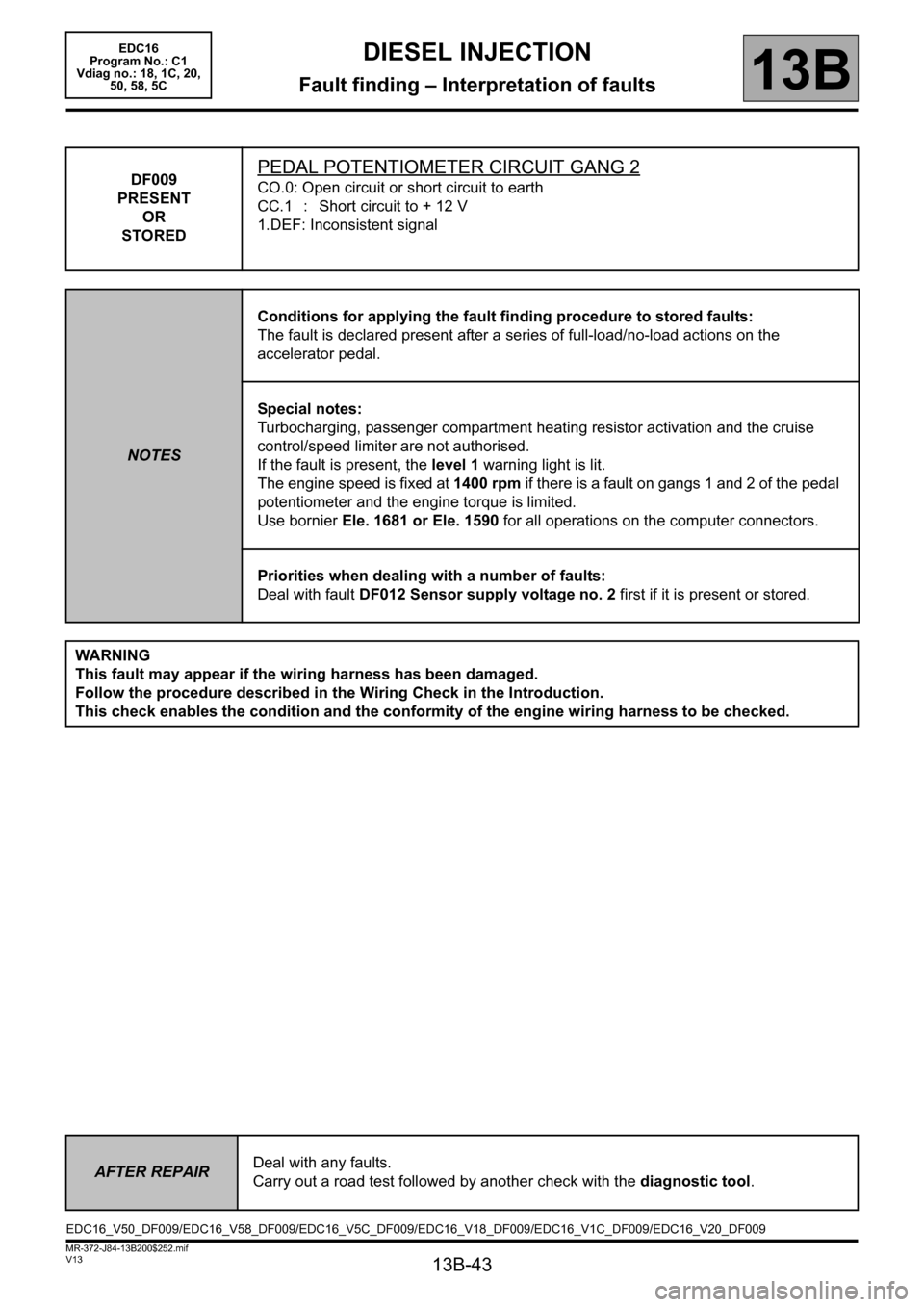
13B-43
MR-372-J84-13B200$252.mif
V13
DIESEL INJECTION
Fault finding – Interpretation of faults
EDC16
Program No.: C1
Vdiag no.: 18, 1C, 20,
50, 58, 5C
13B
DF009
PRESENT
OR
STOREDPEDAL POTENTIOMETER CIRCUIT GANG 2
CO.0: Open circuit or short circuit to earth
CC.1 : Short circuit to + 12 V
1.DEF: Inconsistent signal
NOTESConditions for applying the fault finding procedure to stored faults:
The fault is declared present after a series of full-load/no-load actions on the
accelerator pedal.
Special notes:
Turbocharging, passenger compartment heating resistor activation and the cruise
control/speed limiter are not authorised.
If the fault is present, the level 1 warning light is lit.
The engine speed is fixed at 1400 rpm if there is a fault on gangs 1 and 2 of the pedal
potentiometer and the engine torque is limited.
Use bornier Ele. 1681 or Ele. 1590 for all operations on the computer connectors.
Priorities when dealing with a number of faults:
Deal with fault DF012 Sensor supply voltage no. 2 first if it is present or stored.
WARNING
This fault may appear if the wiring harness has been damaged.
Follow the procedure described in the Wiring Check in the Introduction.
This check enables the condition and the conformity of the engine wiring harness to be checked.
AFTER REPAIRDeal with any faults.
Carry out a road test followed by another check with the diagnostic tool.
EDC16_V50_DF009/EDC16_V58_DF009/EDC16_V5C_DF009/EDC16_V18_DF009/EDC16_V1C_DF009/EDC16_V20_DF009
Page 47 of 365
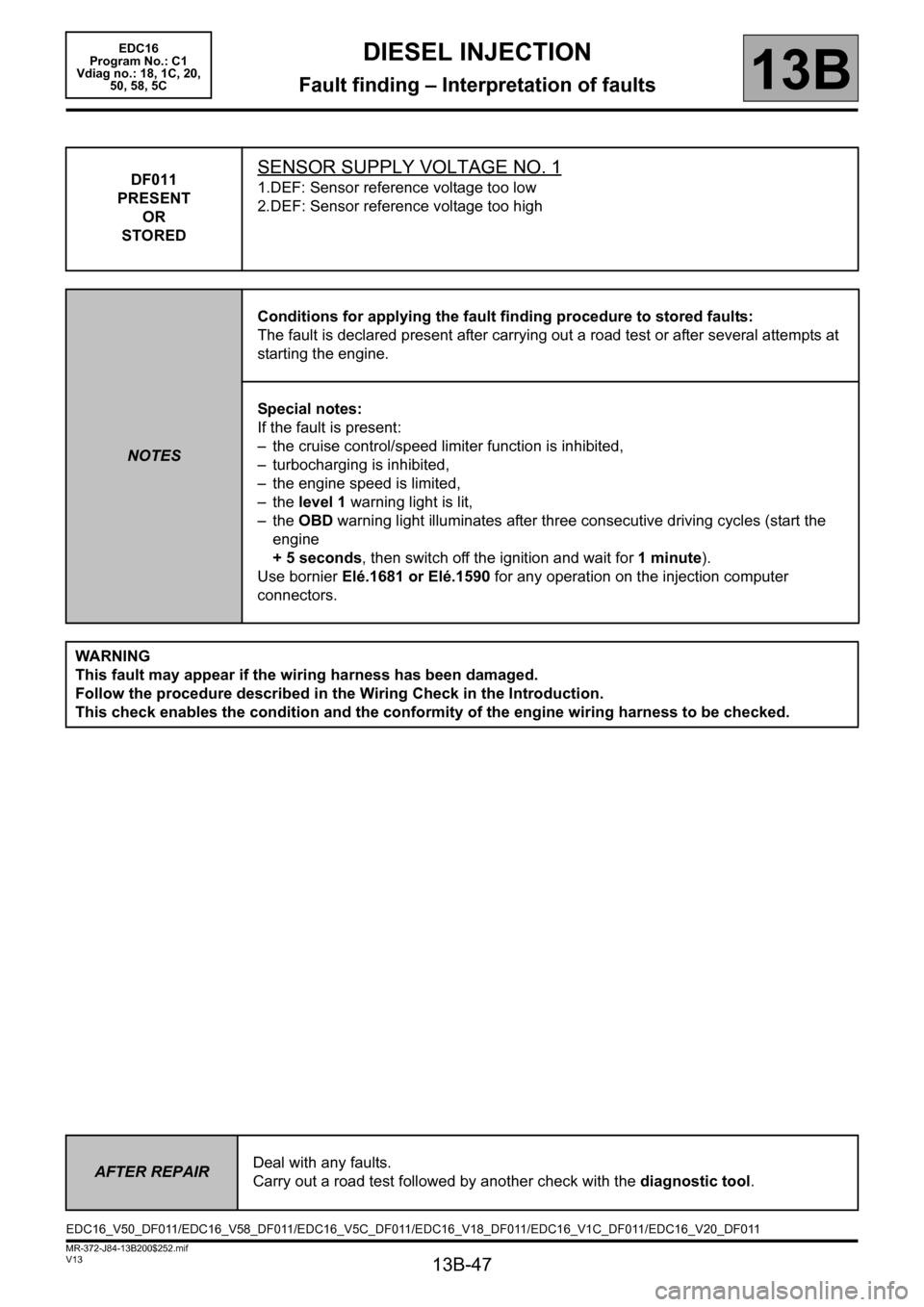
13B-47
MR-372-J84-13B200$252.mif
V13
DIESEL INJECTION
Fault finding – Interpretation of faults
EDC16
Program No.: C1
Vdiag no.: 18, 1C, 20,
50, 58, 5C
13B
DF011
PRESENT
OR
STOREDSENSOR SUPPLY VOLTAGE NO. 1
1.DEF: Sensor reference voltage too low
2.DEF: Sensor reference voltage too high
NOTESConditions for applying the fault finding procedure to stored faults:
The fault is declared present after carrying out a road test or after several attempts at
starting the engine.
Special notes:
If the fault is present:
– the cruise control/speed limiter function is inhibited,
– turbocharging is inhibited,
– the engine speed is limited,
– the level 1 warning light is lit,
– the OBD warning light illuminates after three consecutive driving cycles (start the
engine
+ 5 seconds, then switch off the ignition and wait for 1 minute).
Use bornier Elé.1681 or Elé.1590 for any operation on the injection computer
connectors.
WARNING
This fault may appear if the wiring harness has been damaged.
Follow the procedure described in the Wiring Check in the Introduction.
This check enables the condition and the conformity of the engine wiring harness to be checked.
AFTER REPAIRDeal with any faults.
Carry out a road test followed by another check with the diagnostic tool.
EDC16_V50_DF011/EDC16_V58_DF011/EDC16_V5C_DF011/EDC16_V18_DF011/EDC16_V1C_DF011/EDC16_V20_DF011
Page 48 of 365
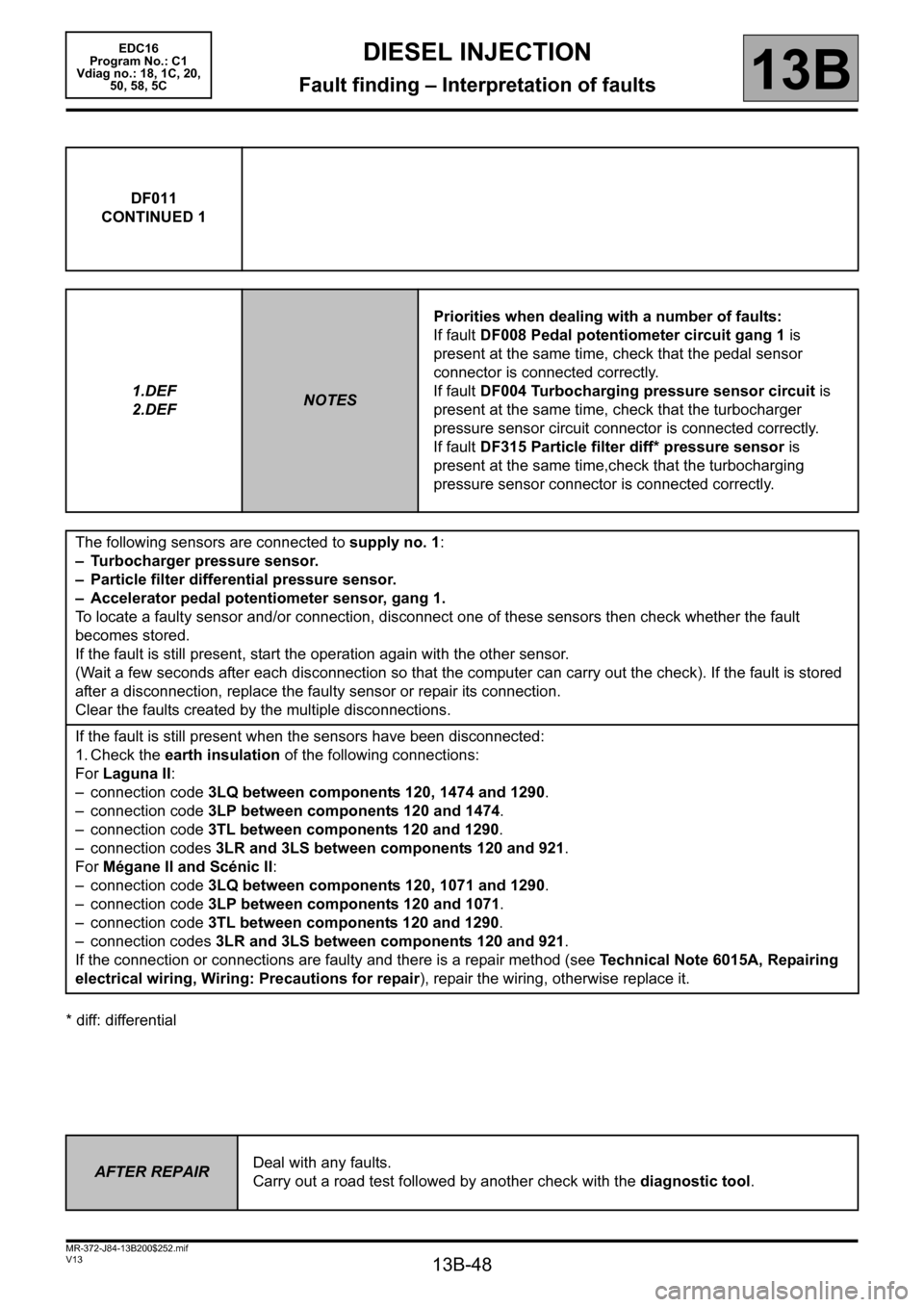
13B-48
MR-372-J84-13B200$252.mif
V13
DIESEL INJECTION
Fault finding – Interpretation of faults
EDC16
Program No.: C1
Vdiag no.: 18, 1C, 20,
50, 58, 5C
13B
* diff: differentialDF011
CONTINUED 1
1.DEF
2.DEF
NOTESPriorities when dealing with a number of faults:
If fault DF008 Pedal potentiometer circuit gang 1 is
present at the same time, check that the pedal sensor
connector is connected correctly.
If fault DF004 Turbocharging pressure sensor circuit is
present at the same time, check that the turbocharger
pressure sensor circuit connector is connected correctly.
If fault DF315 Particle filter diff* pressure sensor is
present at the same time,check that the turbocharging
pressure sensor connector is connected correctly.
The following sensors are connected to supply no. 1:
– Turbocharger pressure sensor.
– Particle filter differential pressure sensor.
– Accelerator pedal potentiometer sensor, gang 1.
To locate a faulty sensor and/or connection, disconnect one of these sensors then check whether the fault
becomes stored.
If the fault is still present, start the operation again with the other sensor.
(Wait a few seconds after each disconnection so that the computer can carry out the check). If the fault is stored
after a disconnection, replace the faulty sensor or repair its connection.
Clear the faults created by the multiple disconnections.
If the fault is still present when the sensors have been disconnected:
1. Check the earth insulation of the following connections:
For Laguna II:
– connection code 3LQ between components 120, 1474 and 1290.
– connection code 3LP between components 120 and 1474.
– connection code 3TL between components 120 and 1290.
– connection codes 3LR and 3LS between components 120 and 921.
For Mégane II and Scénic II:
– connection code 3LQ between components 120, 1071 and 1290.
– connection code 3LP between components 120 and 1071.
– connection code 3TL between components 120 and 1290.
– connection codes 3LR and 3LS between components 120 and 921.
If the connection or connections are faulty and there is a repair method (see Technical Note 6015A, Repairing
electrical wiring, Wiring: Precautions for repair), repair the wiring, otherwise replace it.
AFTER REPAIRDeal with any faults.
Carry out a road test followed by another check with the diagnostic tool.
Page 49 of 365

13B-49
MR-372-J84-13B200$252.mif
V13
DIESEL INJECTION
Fault finding – Interpretation of faults
EDC16
Program No.: C1
Vdiag no.: 18, 1C, 20,
50, 58, 5C
13B
DF011
CONTINUED 2
2. Check the insulation against + 12 V of the following connections:
– connection code 3LP,
– connection code 3LN,
– connection code 3LQ,
– connection code3TL,
– connection code 3TK,
– connection code 3LT,
– connection code 3LS,
– connection code 3LR,
between components 120, 1071, 921 and 1290.
If the connection or connections are faulty and there is a repair method (see Technical Note 6015A, Repairing
electrical wiring, Wiring: Precautions for repair), repair the wiring, otherwise replace it.
3. Check the insulation between the following connections after disconnecting the sensors and the injection
computer:
– connection codes 3LN and 3LQ of the turbocharging pressure sensor,
– connection codes 3LQ and 3TK of the particle filter differential pressure sensor,
– connection codes 3LS and 3LU of pedal sensor gang 1.
If the connection or connections are faulty and there is a repair method (see Technical Note 6015A, Repairing
electrical wiring, Wiring: Precautions for repair), repair the wiring, otherwise replace it.
If these checks do not produce the correct results, replace the faulty sensor(s).
If the fault is still present, contact the Techline.
AFTER REPAIRDeal with any faults.
Carry out a road test followed by another check with the diagnostic tool.
Page 73 of 365
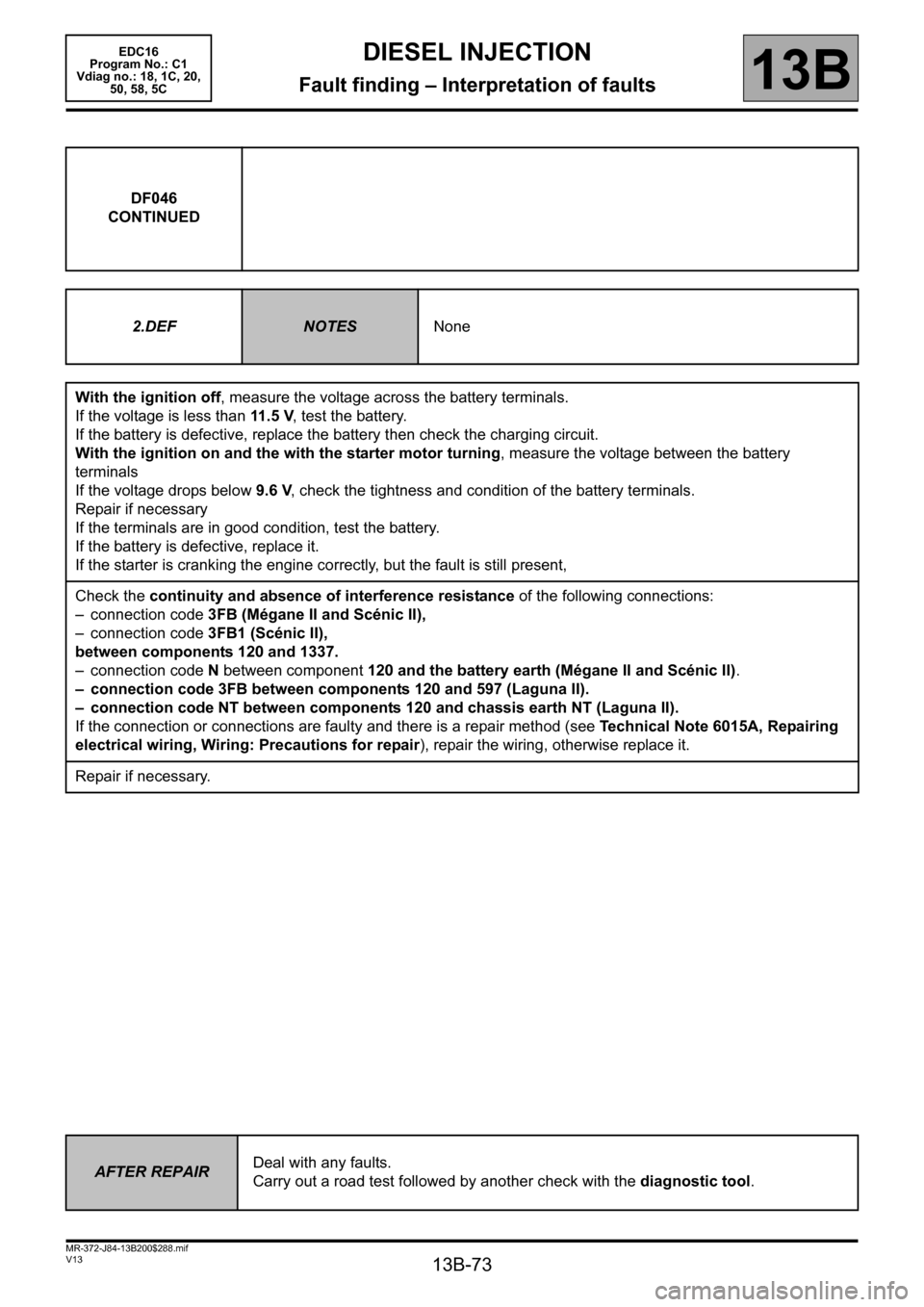
13B-73
MR-372-J84-13B200$288.mif
V13
DIESEL INJECTION
Fault finding – Interpretation of faults
EDC16
Program No.: C1
Vdiag no.: 18, 1C, 20,
50, 58, 5C
13B
DF046
CONTINUED
2.DEF
NOTESNone
With the ignition off, measure the voltage across the battery terminals.
If the voltage is less than 11.5 V, test the battery.
If the battery is defective, replace the battery then check the charging circuit.
With the ignition on and the with the starter motor turning, measure the voltage between the battery
terminals
If the voltage drops below 9.6 V, check the tightness and condition of the battery terminals.
Repair if necessary
If the terminals are in good condition, test the battery.
If the battery is defective, replace it.
If the starter is cranking the engine correctly, but the fault is still present,
Check the continuity and absence of interference resistance of the following connections:
– connection code 3FB (Mégane II and Scénic II),
– connection code 3FB1 (Scénic II),
between components 120 and 1337.
– connection code N between component 120 and the battery earth (Mégane II and Scénic II).
– connection code 3FB between components 120 and 597 (Laguna II).
– connection code NT between components 120 and chassis earth NT (Laguna II).
If the connection or connections are faulty and there is a repair method (see Technical Note 6015A, Repairing
electrical wiring, Wiring: Precautions for repair), repair the wiring, otherwise replace it.
Repair if necessary.
AFTER REPAIRDeal with any faults.
Carry out a road test followed by another check with the diagnostic tool.
Page 85 of 365
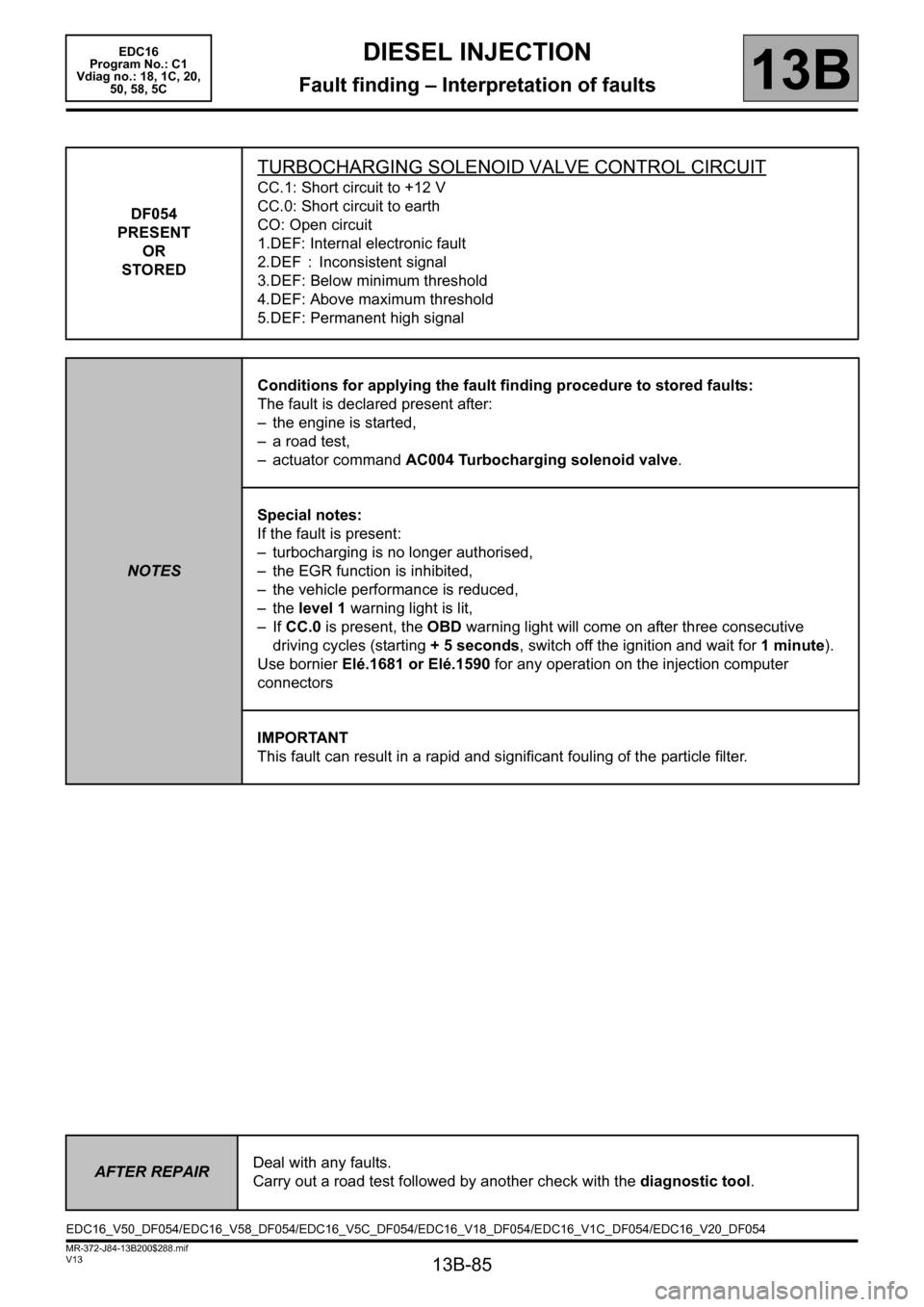
13B-85
MR-372-J84-13B200$288.mif
V13
DIESEL INJECTION
Fault finding – Interpretation of faults
EDC16
Program No.: C1
Vdiag no.: 18, 1C, 20,
50, 58, 5C
13B
DF054
PRESENT
OR
STORED
TURBOCHARGING SOLENOID VALVE CONTROL CIRCUIT
CC.1: Short circuit to +12 V
CC.0: Short circuit to earth
CO: Open circuit
1.DEF: Internal electronic fault
2.DEF : Inconsistent signal
3.DEF: Below minimum threshold
4.DEF: Above maximum threshold
5.DEF: Permanent high signal
NOTESConditions for applying the fault finding procedure to stored faults:
The fault is declared present after:
– the engine is started,
– a road test,
– actuator command AC004 Turbocharging solenoid valve.
Special notes:
If the fault is present:
– turbocharging is no longer authorised,
– the EGR function is inhibited,
– the vehicle performance is reduced,
– the level 1 warning light is lit,
–If CC.0 is present, the OBD warning light will come on after three consecutive
driving cycles (starting + 5 seconds, switch off the ignition and wait for 1 minute).
Use bornier Elé.1681 or Elé.1590 for any operation on the injection computer
connectors
IMPORTANT
This fault can result in a rapid and significant fouling of the particle filter.
AFTER REPAIRDeal with any faults.
Carry out a road test followed by another check with the diagnostic tool.
EDC16_V50_DF054/EDC16_V58_DF054/EDC16_V5C_DF054/EDC16_V18_DF054/EDC16_V1C_DF054/EDC16_V20_DF054
Page 86 of 365
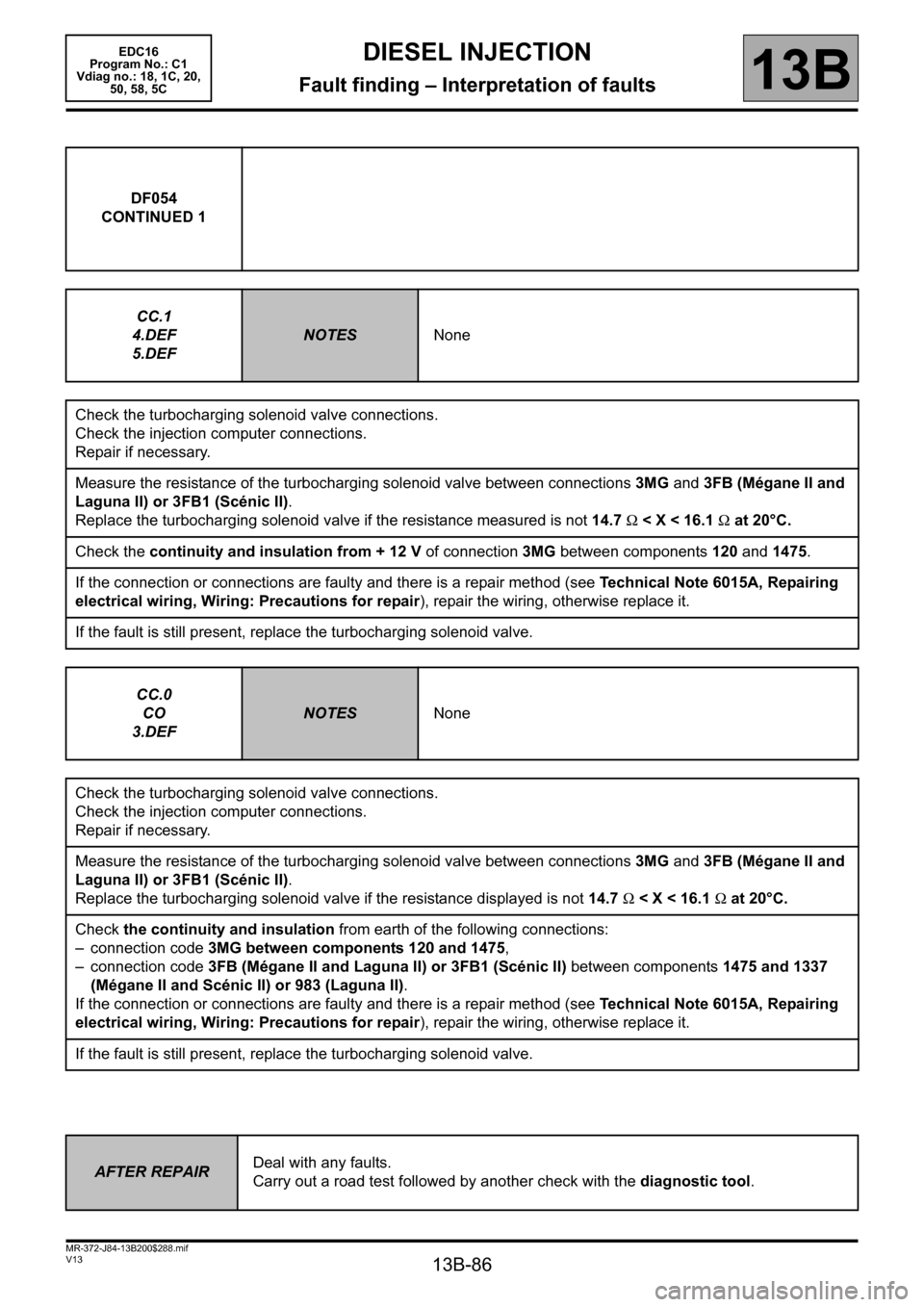
13B-86
MR-372-J84-13B200$288.mif
V13
DIESEL INJECTION
Fault finding – Interpretation of faults
EDC16
Program No.: C1
Vdiag no.: 18, 1C, 20,
50, 58, 5C
13B
DF054
CONTINUED 1
CC.1
4.DEF
5.DEF
NOTESNone
Check the turbocharging solenoid valve connections.
Check the injection computer connections.
Repair if necessary.
Measure the resistance of the turbocharging solenoid valve between connections 3MG and 3FB (Mégane II and
Laguna II) or 3FB1 (Scénic II).
Replace the turbocharging solenoid valve if the resistance measured is not 14.7 Ω < X < 16.1 Ω at 20°C.
Check the continuity and insulation from + 12 V of connection 3MG between components 120 and 1475.
If the connection or connections are faulty and there is a repair method (see Technical Note 6015A, Repairing
electrical wiring, Wiring: Precautions for repair), repair the wiring, otherwise replace it.
If the fault is still present, replace the turbocharging solenoid valve.
CC.0
CO
3.DEF
NOTESNone
Check the turbocharging solenoid valve connections.
Check the injection computer connections.
Repair if necessary.
Measure the resistance of the turbocharging solenoid valve between connections 3MG and 3FB (Mégane II and
Laguna II) or 3FB1 (Scénic II).
Replace the turbocharging solenoid valve if the resistance displayed is not 14.7 Ω < X < 16.1 Ω at 20°C.
Check the continuity and insulation from earth of the following connections:
– connection code 3MG between components 120 and 1475,
– connection code 3FB (Mégane II and Laguna II) or 3FB1 (Scénic II) between components 1475 and 1337
(Mégane II and Scénic II) or 983 (Laguna II).
If the connection or connections are faulty and there is a repair method (see Technical Note 6015A, Repairing
electrical wiring, Wiring: Precautions for repair), repair the wiring, otherwise replace it.
If the fault is still present, replace the turbocharging solenoid valve.
AFTER REPAIRDeal with any faults.
Carry out a road test followed by another check with the diagnostic tool.
Page 87 of 365
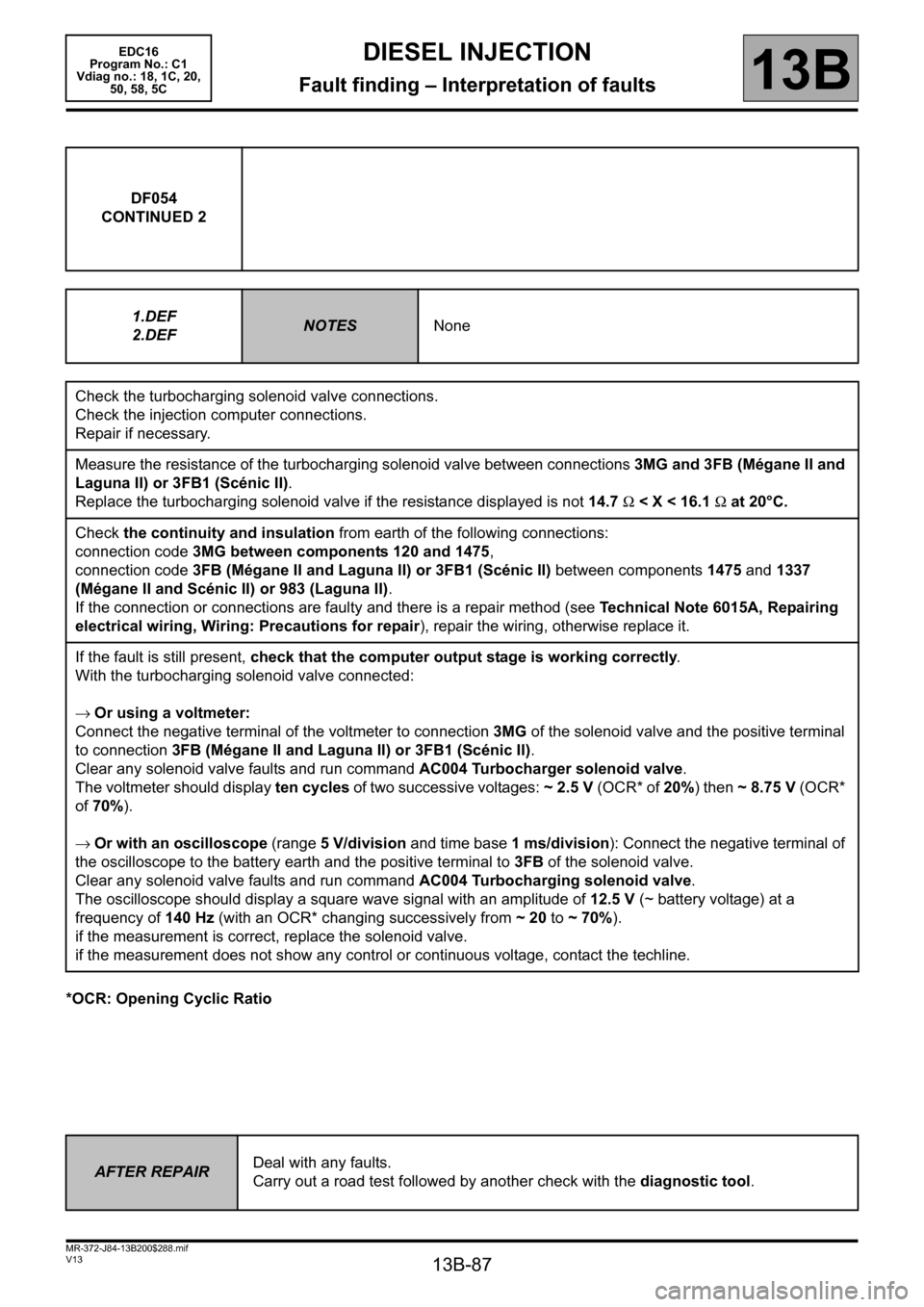
13B-87
MR-372-J84-13B200$288.mif
V13
DIESEL INJECTION
Fault finding – Interpretation of faults
EDC16
Program No.: C1
Vdiag no.: 18, 1C, 20,
50, 58, 5C
13B
*OCR: Opening Cyclic RatioDF054
CONTINUED 2
1.DEF
2.DEF
NOTESNone
Check the turbocharging solenoid valve connections.
Check the injection computer connections.
Repair if necessary.
Measure the resistance of the turbocharging solenoid valve between connections 3MG and 3FB (Mégane II and
Laguna II) or 3FB1 (Scénic II).
Replace the turbocharging solenoid valve if the resistance displayed is not 14.7 Ω < X < 16.1 Ω at 20°C.
Check the continuity and insulation from earth of the following connections:
connection code 3MG between components 120 and 1475,
connection code 3FB (Mégane II and Laguna II) or 3FB1 (Scénic II) between components 1475 and 1337
(Mégane II and Scénic II) or 983 (Laguna II).
If the connection or connections are faulty and there is a repair method (see Technical Note 6015A, Repairing
electrical wiring, Wiring: Precautions for repair), repair the wiring, otherwise replace it.
If the fault is still present, check that the computer output stage is working correctly.
With the turbocharging solenoid valve connected:
→Or using a voltmeter:
Connect the negative terminal of the voltmeter to connection 3MG of the solenoid valve and the positive terminal
to connection 3FB (Mégane II and Laguna II) or 3FB1 (Scénic II).
Clear any solenoid valve faults and run command AC004 Turbocharger solenoid valve.
The voltmeter should display ten cycles of two successive voltages: ~2.5V (OCR* of 20%) then ~8.75V (OCR*
of 70%).
→ Or with an oscilloscope (range 5 V/division and time base 1 ms/division): Connect the negative terminal of
the oscilloscope to the battery earth and the positive terminal to 3FB of the solenoid valve.
Clear any solenoid valve faults and run command AC004 Turbocharging solenoid valve.
The oscilloscope should display a square wave signal with an amplitude of 12.5 V (~ battery voltage) at a
frequency of 140 Hz (with an OCR* changing successively from ~ 20 to ~ 70%).
if the measurement is correct, replace the solenoid valve.
if the measurement does not show any control or continuous voltage, contact the techline.
AFTER REPAIRDeal with any faults.
Carry out a road test followed by another check with the diagnostic tool.
Page 88 of 365
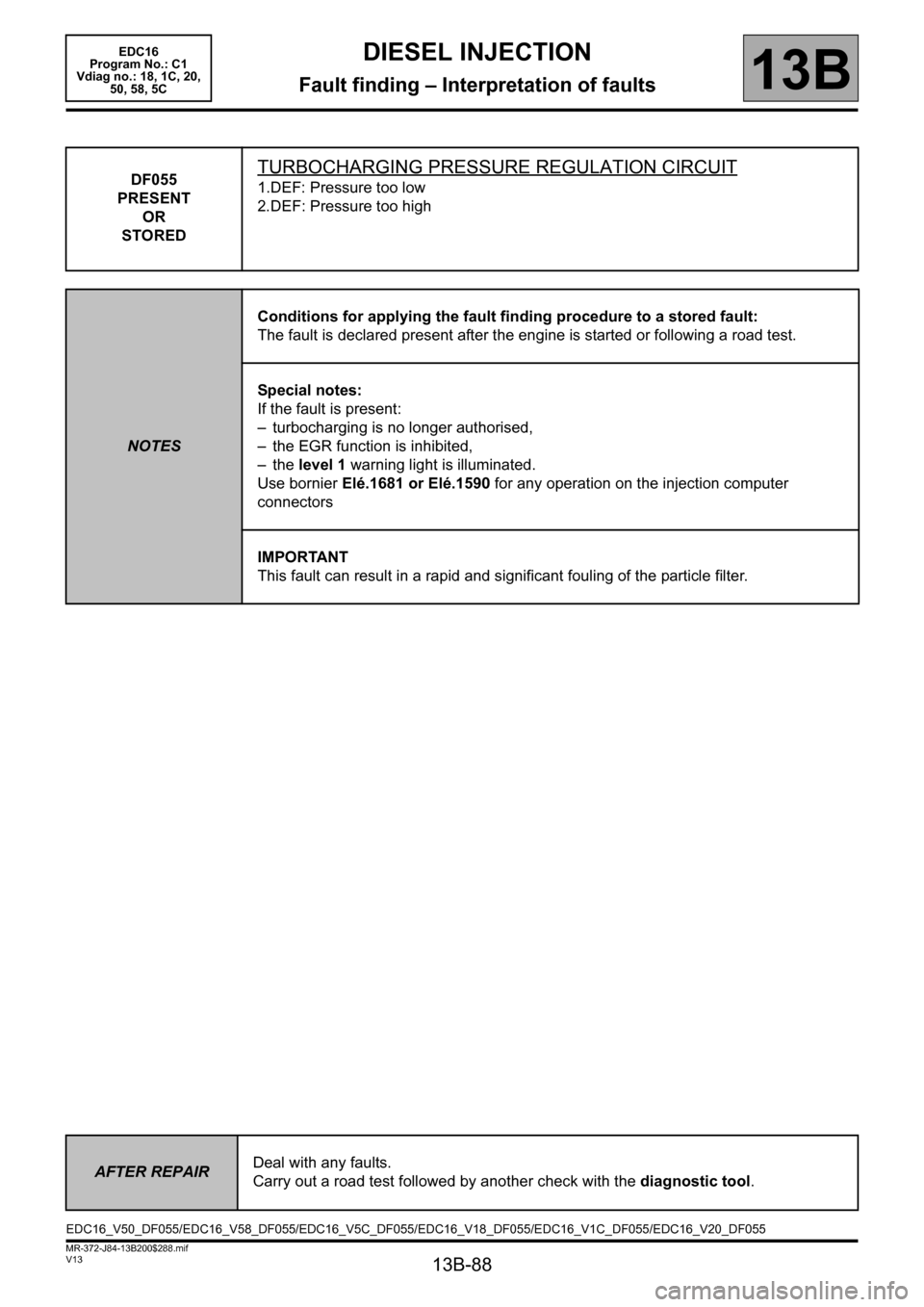
13B-88
MR-372-J84-13B200$288.mif
V13
DIESEL INJECTION
Fault finding – Interpretation of faults
EDC16
Program No.: C1
Vdiag no.: 18, 1C, 20,
50, 58, 5C
13B
DF055
PRESENT
OR
STOREDTURBOCHARGING PRESSURE REGULATION CIRCUIT
1.DEF: Pressure too low
2.DEF: Pressure too high
NOTESConditions for applying the fault finding procedure to a stored fault:
The fault is declared present after the engine is started or following a road test.
Special notes:
If the fault is present:
– turbocharging is no longer authorised,
– the EGR function is inhibited,
– the level 1 warning light is illuminated.
Use bornier Elé.1681 or Elé.1590 for any operation on the injection computer
connectors
IMPORTANT
This fault can result in a rapid and significant fouling of the particle filter.
AFTER REPAIRDeal with any faults.
Carry out a road test followed by another check with the diagnostic tool.
EDC16_V50_DF055/EDC16_V58_DF055/EDC16_V5C_DF055/EDC16_V18_DF055/EDC16_V1C_DF055/EDC16_V20_DF055
Page 89 of 365
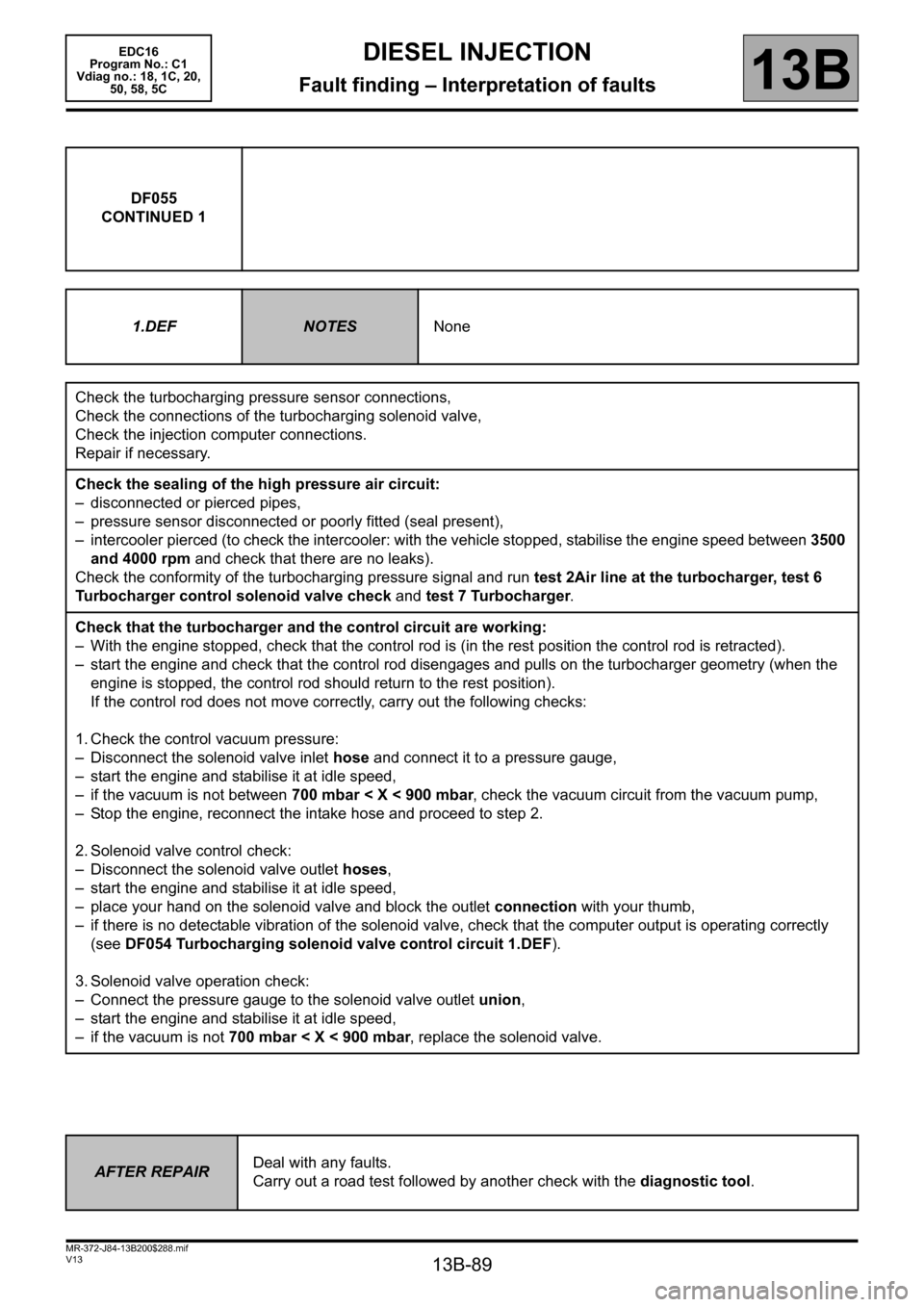
13B-89
MR-372-J84-13B200$288.mif
V13
DIESEL INJECTION
Fault finding – Interpretation of faults
EDC16
Program No.: C1
Vdiag no.: 18, 1C, 20,
50, 58, 5C
13B
DF055
CONTINUED 1
1.DEF
NOTESNone
Check the turbocharging pressure sensor connections,
Check the connections of the turbocharging solenoid valve,
Check the injection computer connections.
Repair if necessary.
Check the sealing of the high pressure air circuit:
– disconnected or pierced pipes,
– pressure sensor disconnected or poorly fitted (seal present),
– intercooler pierced (to check the intercooler: with the vehicle stopped, stabilise the engine speed between 3500
and 4000 rpm and check that there are no leaks).
Check the conformity of the turbocharging pressure signal and run test 2Air line at the turbocharger, test 6
Turbocharger control solenoid valve check and test 7 Turbocharger.
Check that the turbocharger and the control circuit are working:
– With the engine stopped, check that the control rod is (in the rest position the control rod is retracted).
– start the engine and check that the control rod disengages and pulls on the turbocharger geometry (when the
engine is stopped, the control rod should return to the rest position).
If the control rod does not move correctly, carry out the following checks:
1. Check the control vacuum pressure:
– Disconnect the solenoid valve inlet hose and connect it to a pressure gauge,
– start the engine and stabilise it at idle speed,
– if the vacuum is not between 700 mbar < X < 900 mbar, check the vacuum circuit from the vacuum pump,
– Stop the engine, reconnect the intake hose and proceed to step 2.
2. Solenoid valve control check:
– Disconnect the solenoid valve outlet hoses,
– start the engine and stabilise it at idle speed,
– place your hand on the solenoid valve and block the outlet connection with your thumb,
– if there is no detectable vibration of the solenoid valve, check that the computer output is operating correctly
(see DF054 Turbocharging solenoid valve control circuit 1.DEF).
3. Solenoid valve operation check:
– Connect the pressure gauge to the solenoid valve outlet union,
– start the engine and stabilise it at idle speed,
– if the vacuum is not 700 mbar < X < 900 mbar, replace the solenoid valve.
AFTER REPAIRDeal with any faults.
Carry out a road test followed by another check with the diagnostic tool.